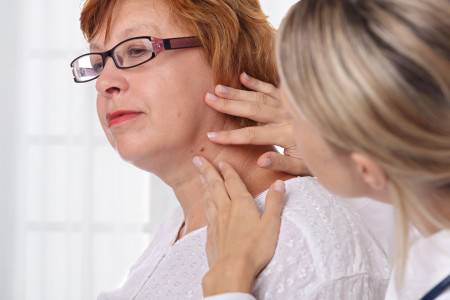How to care for your skin in your 60s and 70s
During our 60s and 70s, skin can feel dry and irritated. This happens for many reasons, including that skin is thinner and loses water more easily. Medications and medical conditions can also play a role.
There is good news. The right skin care can improve how your skin feels — and looks.
Skin becomes drier with age
If your skin feels dry and irritated, the right skin care can help you feel more comfortable.

Skin care changes dermatologists recommend
When it comes to skin care in our 60s and 70s, dermatologists recommend making the following lifestyle changes if you haven’t already done so.
Bathe to relieve dry skin. Some simple changes to your bath time can reduce (or alleviate) dry, itchy skin and prevent dry, itchy from becoming a serious problem. Here’s what you can do:
- Wash with a gentle, fragrance-free, moisturizing bar soap, cleanser, or body wash. Doing so will help soothe rather than dry your skin. Moisturizing ingredients that can help reduce dryness include glycerin, hyaluronic acid, and lanolin.
- Use warm (not hot) water. Hot water strips skin of its natural oils, which can increase skin dryness.
- Use a soft cloth to wash your skin. A buff puff or bath brush can irritate your skin.
- Keep your bath or shower short. You may find that you don’t need to bathe every day. When you bathe, keep it short. Take a 5- to 10-minute bath or shower.
- Pat water gently from your skin after bathing, but leave a bit of water on your skin. Having some water on your skin when you apply moisturizer (next step) helps hydrate your skin.
- Apply a creamy, fragrance-free moisturizer formulated for dry skin within 3 minutes of bathing and throughout the day. Moisturizing helps ease the dryness and restore your skin’s protective barrier. When your skin feels very dry, dermatologists recommend using an ointment instead of a cream. An ointment does a better job of holding water in your skin than does a cream.
Skip the bath oil
You increase your risk of slips and falls when you use bath oil to moisturize your skin, so it's best to avoid bath oil.

Use a humidifier when the air feels dry. Heating and air conditioning can strip humidity from the air. Dry air can make your skin feel dry and itchy.
How skin can change in your 60s and 70s
Everyone ages differently, but during this time in your life, you may notice that your skin is:
- Drier
- Thinner and starting to look paper-like
- Itchy
- Developing more age spots, wrinkles, and creases
- Blotchier
- Irritated easily
- More susceptible to skin infections
- Bruising more easily
- Sweating less
- Healing more slowly
Wear gloves while doing housework and gardening. Working around your house and in your garden can expose your skin to harsh chemicals, sunlight, and other things that can irritate and dry your skin.
Protect your skin from the sun. If you’re seeing more wrinkles, age spots, bruises, and blotches of discolored skin, you may wonder if you still need to protect your skin from the sun.
- Seek shade when outdoors. Seek shade when appropriate, remembering that the sun’s rays are the strongest between 10 a.m. and 2 p.m.
- Wear clothing that protects your skin from the sun. Wear a lightweight and long-sleeved shirt, pants, a wide-brimmed hat, and sunglasses with UV protection when possible. For more effective protection, select clothing with an ultraviolet protection factor (UPF) number on the label.
- Apply a broad-spectrum, water-resistant sunscreen with SPF 30 or higher. You want to apply this to all skin that clothing won’t cover while you’re outside.
Go fragrance free. Fragrance can irritate your skin. To help heal dry, itchy skin and prevent it from coming back, stop using perfumes, colognes, and skin care products that contain fragrance.
Products that are fragrance free say “fragrance free” on the package.“Fragrance free” and “unscented” have different meanings
Unscented products can irritate dry skin, as unscented products generally contain a chemical that covers up the smell of other ingredients so that you cannot smell them. Be sure to use fragrance-free products.
Examine your skin for signs of skin cancer. Around 50 years of age, your risk of developing skin cancer and pre-cancerous growths increases. As the years pass, this risk rises.
Learning how to examine your skin for signs of skin cancer can help you to find skin cancer early. To learn how to examine your skin, watch How to perform a skin self-exam.
If you notice a spot that is different from others, or that changes, itches, or bleeds, you should make an appointment to see a board-certified dermatologist.Dermatologist examining patient’s skin for signs of skin cancer
If you notice a spot that is different from others, or that changes, itches, or bleeds, you should make an appointment to see a board-certified dermatologist.

When to seek a dermatologist's help
While the right skin care can help, medications, surgery, and health problems can take a toll on your skin. A board-certified dermatologist understands the effects each of these can have on your skin and can create a treatment plan tailored to your skin’s needs. A dermatologist can also help you safely treat skin changes, such as age spots and wrinkles.
Related AAD resources
Images
References
Cowdell F. “Care and management of patients with pruritus.” Nurs Older People. 2009;21(7):35-41.
Cowdell F. “Promoting skin health in older people.” Nurs Older People. 2010;22(10):21-6.
Murphree RW. “Impairments in skin integrity.” Nurs Clin North Am. 2017;52(3):405-17.
Thiele JJ and Gilchrest BA. “Aging skin.” In: Nouri K. Skin Cancer. The McGraw-Hill Companies, Inc., China, 2008:17-29.
Van Onselen J. “Skin care in the older person: identifying and managing eczema.” Br J Community Nurs. 2011;16(12):576, 578-80, 582.
White-Chu EF and Reddy M. “Dry skin in the elderly: complexities of a common problem.” Clin Dermatol. 2011;29(1):37-42.
Written by:
Paula Ludmann, MS
Reviewed by:
Bassel H. Mahmoud, MD, PhD, FAAD
Kesha Buster, MD FAAD
Sandy Marchese Johnson, MD, FAAD
Last updated: 9/8/21
 Atopic dermatitis: More FDA-approved treatments
Atopic dermatitis: More FDA-approved treatments
 Biosimilars: 14 FAQs
Biosimilars: 14 FAQs
 How to trim your nails
How to trim your nails
 Relieve uncontrollably itchy skin
Relieve uncontrollably itchy skin
 Fade dark spots
Fade dark spots
 Untreatable razor bumps or acne?
Untreatable razor bumps or acne?
 Tattoo removal
Tattoo removal
 Scar treatment
Scar treatment
 Free materials to help raise skin cancer awareness
Free materials to help raise skin cancer awareness
 Dermatologist-approved lesson plans, activities you can use
Dermatologist-approved lesson plans, activities you can use
 Find a Dermatologist
Find a Dermatologist
 What is a dermatologist?
What is a dermatologist?

